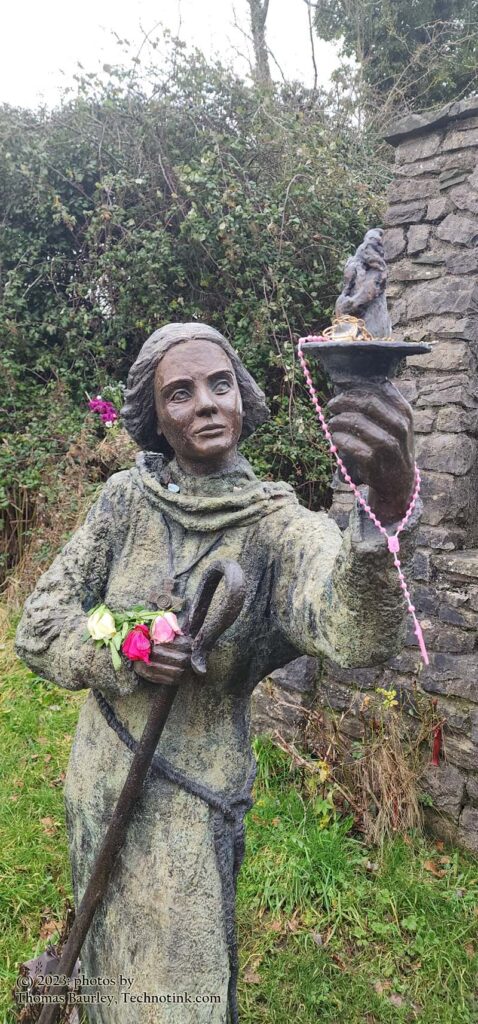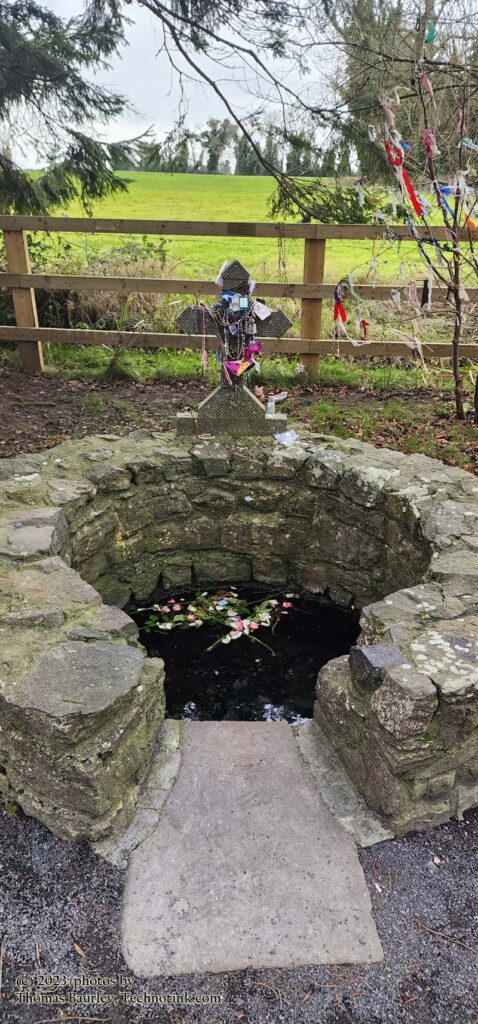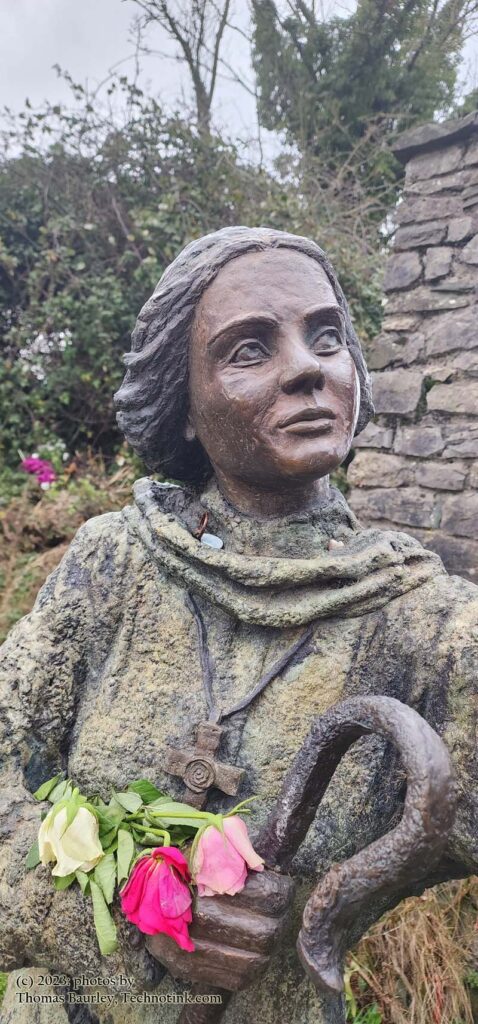The Goddess Brigid
a.k.a. St. Brigid of Kildare, Brigid of Ireland, “Brigit”, “Bridget”, “Bridgit”, “Brid”, “Bride”, “Mary of the Gael”, or “Naomh Brid”
As a Saint and Actual Living Person: St. Brigid – c. 451 – 525 C.E. (A.D.)
Goddess of Poetry, Magic, Healing, Smithcraft, Learning, Common People, Flocks/Stock/Yield of the Earth, and Inspiration.
Patron Saint of Ireland along with Saint Patrick and St. Columba. Early Christian Nun, Abbess, and Founder of several Monasteries.
Holiday: February 1st as “Saint Brigid’s Day, Candlemas, Imbolc, or Oimelc.
As a Saint and Actual Living Person: St. Brigid – c. 451 – 525 C.E. (A.D.) Goddess of Poetry, Magic, Healing, Smithcraft, Learning, Common People, Flocks/Stock/Yield of the Earth, and Inspiration. Patron Saint of Ireland along with Saint Patrick and St. Columba. Early Christian Nun, Abbess, and Founder of several Monasteries. Holiday: February 1st as “Saint Brigid’s Day, Candlemas, Imbolc, or Oimelc.
“As the Goddess: ” Throughout Europe, especially in England and Ireland, was the Pagan worship of the Goddess Brigid. She was the Goddess of Poetry, Magic, Healing, Smithcraft, Learning, Common People, Flocks/Stock/Yield of the Earth, and Inspiration. She is identified in Lebor Gabala ‘renn as the Daughter of Dagda and a poet; a half-sister of Cermait, Aengus, Midir, and Bodb Derg. In the Cath Maige Tuireadh, she is responsible for inventing keening while mourning as well as the whistle used for night travel.
Her British Counterpart Brigantia was the Celtic equivalent of the Roman Minerva and the Greek Athena. She is also the Goddess of all things perceived to be of higher dimensions such as high-rising flames, highlands, hill-forts, upland areas, activities depicted as lofty or elevated such as wisdom, excellence, perfection, high intelligence, poetic eloquence, craftsmanship, healing, Druidic knowledge, the home, the hearth, and skills with warfare.
When the Celts came to Ireland in 500 B.C.E., they brought with them the Druidic religion. Druidism was polytheistic with many Deities who interacted with humanity for good and for bad. It was a common practice for various Deities to be assigned to certain regions or places where a cult site would be established. One was established, as early, if not earlier than, 500 C.E. in what is now known as Kildare.
The shrine and cult were dedicated to the Goddess Brigid. In Celtic cosmology, the chief God was The Dagda Mor (God of musicians, and magic) who ruled over the people of Dana (the Tuatha de Danann or the Faerie folk). Dana was the Mother of Irish God/desses. She was also associated as “Brid” the “Poetess” which is identified with the Goddess “Brigantia” who ruled over the Brigantes – a powerful Celtic tribe in North Britain. Brigantia ruled over water and the rivers – the Brighid in Ireland, the Braint in Wales, and the Brent in England. “Brid” meant “exalted one”.
She is often referred to as a “Triple Goddess” – the Three Sister Goddesses named Brid: (1) Goddess of poetry and traditional learning; (2) Goddess of the Smith’s Art; and (3) Goddess of Healing. Through time, these three Goddesses and their attributes were merged into one figure – the Goddess Brigid. With the coming of Christianity, Paganism became absorbed and purposely phased out by the mainstream populace until eventually it was not tolerated. The Gods and Goddesses of old were diminished down to the same rank as faeries, angels, Saints, and royalty. Many of the ancient Gods and Goddesses were converted to Christian Saints by the Catholic Church as a means to dissolve Pagan belief systems. In Christian times she was converted to a Saint, after the actual St. Brigid of Kildare.
“As the Saint and Historical Person:” St. Brigid was the “Mary of the Gael” and only second in popularity to the people of Ireland next to St. Patrick. She was primarily associated with Kildare, the Curraugh, and the whole region of the Liffey Plain known as “Magh Life”.
St. Brigid was born to Dubtach or Dubhthach, the descendant of Con of the Hundred Battles, a Pagan Chieftain of Leinster; and to Brotseach or Brocca, A Christian Pict of the house of O’Connor who was a slave baptized by St. Patrick. St. Brigid was believed to have been born somewhere between 451-458 C.E (453 most common) at Faughart near Dundalk, County Louth, Ireland.
Some accounts state that Dubhthach, her father, was from Lusitania and kidnapped by Irish pirates and brought to Ireland to work as a slave in the same regard as happened with Saint Patrick. Her mother, Brotseach, was also believed to be a slave of Dubtach who was sold off shortly before Brigid’s birth to a Druid who lived at Faughart a few miles from Dundalk.
Apparently, much of this regard in her life affected Brigid’s views on things, especially with the concept of people being property. Dubtach, her father and his family were natives of Leinster and Fr. Swayne, the late Parish Priest of Kildare, who claims they were from Umaras between Monasterevin and Rathangan in County Kildare.
She was baptized in the Christian faith under the name of “Brid” or “Brigid”. Legend has it though that she was weaned on the milk of a white-red-eared cow, the color of the beasts of the Tuatha De Danann. Throughout her life, Brigid was especially kind to the people she encountered and was notorious in the legend for miracles to be associated with her.
One legend tells of her as a child in charge of the dairy by her mother that she gave away so much milk and butter to the poor people where they lived that none was left for her family. She knew her mother would be furious so resorted to prayer. As an answer to her prayers, when her mother visited the dairy, she found an abundance of milk and butter. She was also known to be a lover of animals and had many tales of her kindness to stray and starving dogs.
In childhood, she supposedly encountered St. Patrick. Supposedly she was brought to hear him preach and when she listened to him, she fell into ecstasy. She was so dedicated to charity, taking care of common people, healing the sick, and her faith that when she reached marriage age, she instead decided to dedicate herself to religious life. Pagan lore states she was one of the guardians of the Sacred Flame and Shrine of the Goddess Brigid in Kildare.
Christian tales tell of her leaving home with seven other young girls and traveling to County Meath where St. Maccaille the Bishop resided. The Bishop was hesitant to instate the girls because of their young age into the order. During prayer, it was here that they experienced a column of fire that reached the roof of the church resting on Brigid’s head. The Bishop gave the veil to the eight young girls upon hearing of this miracle. St. Maccaille’s Church was on Croghan Hill in County Westmeath, and it was here that St. Brigid founded the first convent in Ireland which attracted many ladies of nobility as postulants and it was here that Brigid and her sisters completed their novitiate.
After completion, they journeyed to Ardagh where they made their final vows to St. Mel, the Bishop of Ardagh and nephew of St. Patrick. Brigid founded another convent here and remained for 12 years. At the Bishop’s request, she sent sisters to various parts of Ireland to establish new foundations including herself.
As St. Brigid traveled around Ireland, she visited with St. Patrick when he was preaching at Taillte or Telltown in County Meath to obtain his blessing. Throughout her travels, she conducted blessings and miracles along the way gaining Sainthood. The Leinstermen knew Brigid was from their province and constantly asked for her to return home amongst them and was offered any site in that province. She decided to make her foundation on Druim Criadh near the Liffey in what eventually grew into Kildare. She chose a spot on the ridge of clay near a large oak tree and decided to build her oratory beneath its branches. Purportedly there was already a shrine to the Goddess Brigid here. The new foundation prospered and grew quickly. Girls from all over Ireland and even abroad came to St. Brigid’s Foundation to join the community. The foundation was named after the “Church of the Oak” or “Cill Dara” which evolved into modern-day Kildare. The poor, the afflicted, the sorrowful came to Kildare for Brigid’s healing, advice, and guidance.
Besides a church, Brigid built a small oratory at Kildare which became a center of religion and learning and developed into a Cathedral city with two monastic institutions, one for men and another for women with St. Conleth appointed as spiritual pastor for both of them. She also founded a school of art, including metalwork and illumination that St. Conleth presided over as well. From this was produced the “Book of Kildare” which was praised by Giraldus Cambrensis as having every page fantastically illuminated with interlaced work and a harmony of colors that it was the work of Angels and not of Humans, but it has long since vanished since the Reformation.


An unusual community was developed at Kildare with both monks and nuns at the same location. St. Mel, an old and doddery Bishop was appointed to watch over the foundation and ordain priests there. Legend has it that instead of professing St. Brigid as a nun, he consecrated her as a Bishop giving her all the privileges that came with the title. At some point, the legend of St. Brigid and the Curraugh came into place. She apparently requested land from the King of Leinster, and he laughed at her request telling her he’d give her as much land as her cloak could cover. She spread out her cloak, and it covers the entire extent of the Curraugh, and that is why the Irish believe the Curraugh came to be.
The Kings of Leinster showered gifts onto the convent with the privilege of sanctuary conferred on the foundation so that any law offenders seeking refuge were safe there. St. Brigid chose St. Conleth to be her Bishop. He mounted his chariot and asked for Brigid’s blessing before his journey home near Newbridge. As he raced across the Curraugh, he discovered that his wheel was loose through the entire journey and believed it was Brigid’s blessing that it had not fallen off and killed him. St. Conleth was consecrated as the first Bishop of Kildare in 490. They worked very well together even though they were rumored to have had a complex relationship.
Legend has it that Brigid gave all the vestments which Conleth used for saying Mass to the poor. He became upset with her as he got them in Italy, so Brigid prayed, and vestments exactly resembling those given away immediately manifested, and Conleth was appeased. In 519, St. Conleth decided to go on a pilgrimage to Rome without St. Brigid’s permission or blessings, and he didn’t get very far before being killed by a wolf near Dunlavin in County Wicklow.
No one knows for sure when St. Brigid died, but she was believed to have reached age 70, and is purported to have died between 521-528 C.E. Story has it that upon her deathbed, Saint Ninnidh, or “Ninnidh of the Clean Hand” attended her to administer the last rites of “Ireland’s Patroness”. She was interred at the right of the high altar of the Kildare Cathedral with a costly tomb erected over her. After her death, the monastery flourished.
Around 650, the first “Life of St. Brigid” or “Vita Brigitae” was written by a monk named Cogitosus. Both St. Brigid and St. Conleth were buried in the Church with ornate shrines of gold, silver, gems, precious stones, and ornamentation. In 836 A Danish fleet of 30 ships arrived in the Liffey and another in the Boyne that plundered Kildare with fire and sword carrying off the shrines of St. Brigid and St. Conleth. However, it was said that in premonition for this event, in 835, the order hid the remains of St. Brigid in Downpatrick. Unfortunately, the Danes attacked and plundered Downpatrick as well. To protect her body and remains, the priests buried her in a secret place only those priests knew which has now been lost.
In 1185 St. Malachy sought out St. Brigid’s burial place which was supposed to have been buried with St. Patrick and St. Columba claiming to have found their resting places. He petitioned Pope Urban 111 to reinter the remains of all of them to Down Cathedral and did so on 9 June 1186 during the Feast of St. Columcille. During Henry VIII’s reign, during the Dissolution, the new shrine was desecrated, and the relics of the Saints were scattered except some were saved from destruction. The hand (some accounts state the head) of St. Brigid now rests in Lumiar, Portugal (near Lisbon) in a chapel devoted to her in the Church of St. John the Baptist. Another of her body parts as a relic is located in St. Martin’s in Cologne. St Brigid’s Day.
Current Observations of St. Brigid: St. Brigid is highly revered in Roman Catholicism, especially in Ireland and England. In addition, many Eastern Orthodox Christians venerate her as one of the great Western saints before the schism between the Eastern and Western Churches.
St. Brigid and the Goddess Brigid are celebrated on the 1st of February, the Pagan feast of Imbolc, the Festival of Spring celebrating the coming of fertility to the land. It is common to make a Brid’s bed and Brigid Cross in celebration. An eternal flame called “St. Brigid’s Fire” is kept in her honor and since the beginning was tended by 20 “servants of the Lord” with Brigid being the 20th attendee. Since her death, she miraculously tends the fire which never goes out, but is still aided by 19 sisters or attendees keeping the flame alive.
The flame has been kept alive uninterrupted for over 1,000 years with only one interruption in the 1200s when Henry of London, Norman arch-bishop of Dublin, ordered it to be extinguished as he believed this to be a Pagan practice. It was immediately re-lit by the locals but finally extinguished during the Reformation.
St. Brigid Crosses are still weaved to this day as a symbol of sun worship representing the sun in the center with rays of light coming from it in the shapes of the arms of the Cross. St. Brigid has two Sacred Wells and a Wishing Tree in Kildare. She has numerous wells associated with her throughout the world, the most notable being in England and Ireland. These were sites of veneration for the Druidic faith, and many had an associated sacred tree commonly referred to these days as a “wishing tree” where votive offerings of cloth were tied for healing or prayer petitions. Brigid’s girdle is capable of curing all diseases and illness and so the waters of her well and the sacred trees are pilgrimaged by people from all over the world for healing. As earlier mentioned, St. Brigid is next to St. Patrick in popularity with the Irish and has dedicants, dedications, shrines, and orders to her throughout Ireland and Britain.







